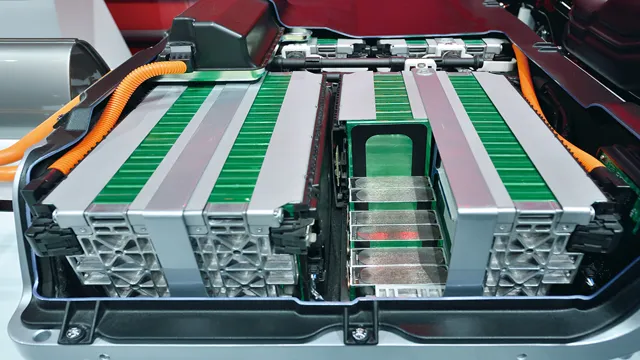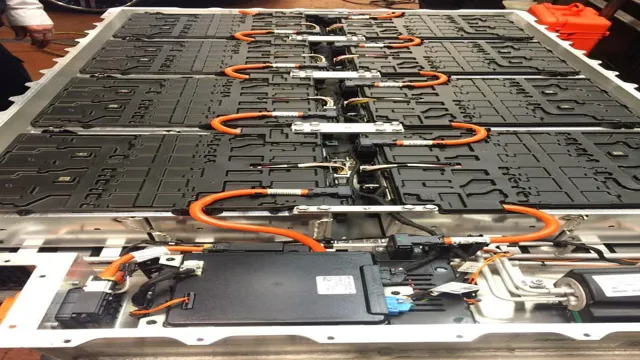The Ultimate Guide to Electric Car Batteries: Exploring the Different Types
As we move towards a greener future, electric cars are becoming increasingly popular. However, one of the biggest concerns that people have is the battery. What kind of battery does an electric car use? How long does it last? These are all valid questions – after all, the battery is the heart of the electric car.
In this blog post, we will take a deep dive into the world of electric car battery types. We’ll explore the different types of batteries available, how they work, their advantages and disadvantages, and which electric cars use which battery types. So, whether you’re a curious car enthusiast or someone considering purchasing an electric vehicle, this blog post is for you.
By the end, you’ll have a better understanding of electric car batteries and which one is right for you.
Lead-Acid Batteries
When it comes to electric car batteries types, one of the most common options you’ll find is the lead-acid battery. These have been around for more than a century, and are still widely used today thanks to their affordability and reliability. Lead-acid batteries are made up of lead plates and an acid electrolyte solution, which creates a chemical reaction that produces electricity.
They can be recharged using an external power source, and typically have a lifespan of around five years. While these batteries are less efficient than some of the newer options available, they are still widely used in smaller electric vehicle models due to their affordability and reliable performance. However, if you’re looking for a battery option that optimizes for energy density and longevity at a higher price point, you may want to consider other battery types like lithium-ion.
Ultimately, the right choice will depend on your individual needs and budget.
Description and Characteristics
Lead-acid batteries are a common type of rechargeable battery used in a wide range of applications. One of the most significant advantages of lead-acid batteries is their low cost relative to other types of batteries. They are also durable, reliable, and can provide a high level of power output.
Lead-acid batteries are commonly used in automobiles, as they are capable of delivering the high levels of power required to start an engine. They are also used in renewable energy systems, as they can store energy generated by solar panels or wind turbines. While lead-acid batteries have many benefits, they do have some downsides as well.
For example, they are relatively heavy and bulky, which can make them unsuitable for applications where weight is a consideration. They also require regular maintenance, which can be time-consuming and expensive. Overall, however, lead-acid batteries are a versatile and reliable type of battery that are well-suited to many different applications.

Advantages and Disadvantages
Lead-acid batteries have been in use for over a century and offer several advantages and disadvantages. One significant advantage of these batteries is their low cost, which makes them a popular choice for many applications. They are also easily available and recyclable, making them an environmentally friendly option.
Lead-acid batteries can handle high current loads, making them ideal for applications that require a sudden high burst of power, like starting an automobile. On the downside, these batteries have a relatively short lifespan, typically lasting between three to five years. Over time, their performance and capacity gradually decline, and they become less efficient.
Lead-acid batteries are also heavy and bulky, making them unsuitable for applications that require portability or space restrictions. Additionally, lead-acid batteries require regular maintenance, including checking the water levels and topping them up, to ensure optimal performance. Overall, while lead-acid batteries have some benefits, they are not suitable for all applications and should be selected based on the specific requirements of the device.
Lithium-Ion Batteries
When it comes to powering electric cars, the type of battery used can make a big difference. One common type of electric car battery is the lithium-ion battery. These batteries are known for their high energy density, which means they can hold a lot of energy in a small space.
They also have a relatively long lifespan and can be recharged quickly. However, they can be expensive to produce and can be a fire hazard if they are damaged or improperly charged. Despite these challenges, lithium-ion batteries are currently the most popular technology for electric cars, and advancements are being made to make them even more efficient and safe.
So if you’re considering an electric car, chances are it will be powered by a lithium-ion battery!
Description and Characteristics
Lithium-ion batteries have become popular in recent years due to their high energy density, light weight, and the ability to recharge multiple times. They are commonly used in electronic devices such as laptops, smartphones, and electric vehicles. One of the key characteristics of lithium-ion batteries is their long lifespan, lasting up to three years or more with proper care.
They also have a low self-discharge rate, meaning they can retain their charge for longer periods, making them ideal for devices that are not used regularly. Additionally, lithium-ion batteries are more environmentally friendly than other battery types due to the absence of toxic heavy metals such as lead and mercury. However, they can be prone to overheating and even bursting if not handled correctly or when damaged.
In conclusion, lithium-ion batteries are a reliable and efficient power source for our modern-day electronic gadgets, but it’s crucial to handle them with care to avoid any mishaps.
Advantages and Disadvantages
Lithium-ion batteries are widely used in different electronic devices, and one of the primary reasons is their high energy density. These batteries can store more energy in a smaller and lighter package than other types of batteries. Another advantage of lithium-ion batteries is their long lifespan compared to other rechargeable batteries.
These batteries also have a low self-discharge rate, making them perfect for devices that need to remain charged for more extended periods. However, these batteries aren’t perfect, and they do come with some disadvantages. One of the significant drawbacks of lithium-ion batteries is their cost.
These batteries are expensive to manufacture, which reflects in their higher purchasing prices. Another disadvantage of these batteries is their sensitivity to high temperatures, which can lead to a reduced lifespan. In summary, lithium-ion batteries have made a significant impact in the world of electronics due to their high energy density, long lifespan, and low self-discharge rate, but they do come with a higher cost than some other types of batteries and can be sensitive to temperature.
Examples of Electric Cars That Use Lithium-Ion Batteries
Lithium-ion batteries have become the go-to power source for electric cars, thanks to their efficiency and reliability. These batteries are a type of rechargeable battery that uses lithium ions to store and release energy. They are lightweight, have a high energy density, and can be recharged quickly.
Many electric car manufacturers use lithium-ion batteries to power their vehicles. For example, the Tesla Model S uses a lithium-ion battery pack that weighs around 1,200 pounds and has a range of up to 373 miles. The Nissan Leaf and Chevrolet Bolt are also popular electric cars that use lithium-ion batteries.
In fact, most electric cars on the market today rely on this technology. With continued advancements in battery technology, we can expect even better performance and increased range in future electric cars.
Nickel-Metal Hydride Batteries
When it comes to electric car batteries types, nickel-metal hydride (NiMH) batteries are a popular option. These batteries are known for their high energy density, which means they can store more energy in a smaller space than many other types of batteries. This makes them ideal for use in electric cars, where space is often a premium.
Additionally, NiMH batteries are more environmentally friendly than many other types of batteries because they do not contain toxic materials like lead. However, they are not without their drawbacks. NiMH batteries can be more expensive than other types of batteries, and they can also take longer to charge.
Nonetheless, for those seeking a balance between power and environmental friendliness, NiMH batteries may be a good choice for electric car batteries.
Description and Characteristics
Nickel-metal hydride batteries are rechargeable batteries that have gained popularity in recent years due to their environmentally-friendly properties. These batteries use hydrogen ions as their fuel source, which is stored in a metal alloy. The use of hydrogen in the battery chemistry provides a higher energy density than a traditional nickel-cadmium battery, allowing for longer run times.
Additionally, nickel-metal hydride batteries have a lower memory effect than other rechargeable batteries, meaning that they do not lose their maximum capacity over time with frequent charging. These batteries are commonly used in everyday devices such as digital cameras, laptops, and cordless power tools due to their durability and reliability. With proper care and maintenance, nickel-metal hydride batteries can have a long lifespan and provide a more sustainable energy option for consumers.
Advantages and Disadvantages
When it comes to rechargeable batteries, nickel-metal hydride (NiMH) batteries are a popular choice due to their high energy density and longer shelf life compared to their predecessors. One major advantage of these batteries over other types is their ability to hold a charge for longer periods of time, which makes them great for use in devices that don’t require frequent use. Additionally, NiMH batteries are less susceptible to the “memory effect” that plagues other types of rechargeable batteries such as nickel-cadmium (NiCd) batteries.
One disadvantage, however, is that NiMH batteries don’t perform as well as lithium-ion batteries in terms of power output, making them unsuitable for high-drain applications like digital cameras and power tools. Additionally, NiMH batteries tend to self-discharge more quickly than other rechargeable batteries, which can be a problem if you rely on them for emergency backups. Overall, NiMH batteries are a reliable and cost-effective option for a wide range of devices that don’t require high levels of power output or extended use.
Solid-State Batteries
When it comes to electric car batteries types, solid-state batteries are rising in popularity due to their potential to offer better performance and safety than traditional lithium-ion batteries. Unlike lithium-ion batteries that use liquid electrolytes, solid-state batteries use solid electrolytes, making them less prone to leaking, overheating, or catching fire. Additionally, solid-state batteries could offer higher energy density, meaning they could store more energy in a smaller space, ultimately increasing the range of electric vehicles.
However, currently, solid-state batteries are still in the development stage, and their high cost of production and limited production capability are some of the challenges they need to overcome before becoming widely available in electric cars. Nonetheless, research is ongoing, and continued advancements in solid-state battery technology could pave the way for faster charging times, longer ranges, and safer batteries in the future.
Description and Characteristics
Solid-state batteries are considered the next big thing in the world of advanced batteries. Unlike traditional batteries, which use liquid electrolytes, solid-state batteries use solid electrolytes. This provides several advantages, including higher energy density, longer lifespan, and improved safety.
Additionally, solid-state batteries are capable of withstanding extreme temperatures and enable faster charging times. They are also more eco-friendly as they have a reduced risk of leakage or fire hazards. Solid-state batteries are also more resilient and less susceptible to degradation caused by repeated charging and discharging cycles.
They have the potential to revolutionize a wide range of industries, including electronics, electric vehicles, and renewable energy systems. In summary, solid-state batteries are a promising technology with significant benefits over traditional batteries and hold tremendous potential for future development.
Advantages and Disadvantages
Solid-state batteries are a promising technology for the future of energy storage. One advantage of solid-state batteries is their improved safety compared to traditional lithium-ion batteries, which are known to be prone to thermal runaway and can lead to fires or explosions. Solid-state batteries also offer higher energy density, which means they can store more energy in a smaller size than typical batteries.
However, there are also some challenges associated with solid-state batteries. For example, they can be expensive to manufacture and have lower conductivity than liquid-state batteries. Additionally, solid-state batteries are still a new technology and have not yet been widely commercialized, so there is still much research needed to improve and optimize their performance.
Overall, solid-state batteries show a lot of potential, but more research and development is necessary to overcome their limitations and make them a viable alternative to current battery technology.
Conclusion
In conclusion, the world of electric car battery types is constantly evolving and expanding as technology advances. From the early days of lead-acid batteries to the more modern lithium-ion and solid-state options, we have come a long way in our quest for sustainable and efficient transportation. It’s not just about the battery’s power and range anymore, but also its lifespan, recyclability, and overall environmental impact.
So, whether you’re a fan of Tesla’s cutting-edge technology or prefer a more traditional approach, there’s no denying that the future of electric cars is bright, bold, and full of energy.”
FAQs
What are the different types of electric car batteries available in the market?
The most popular types of electric car batteries are Lithium-ion, Nickel-metal hydride, and Lead-acid batteries. Each type has its own advantages and disadvantages in terms of performance, cost, and environmental impact.
Which type of electric car battery is the most efficient?
Lithium-ion (Li-ion) batteries are currently the most efficient type of electric car battery in terms of energy density, weight, and performance. They have a higher energy density than other types, which means that they can store more energy in a smaller and lighter package.
What is the typical lifespan of an electric car battery?
The lifespan of an electric car battery can vary depending on the type of battery, the usage pattern, and the maintenance practices. Lithium-ion batteries, which are the most common type used in electric cars, usually have a lifespan of 8-10 years or around 100,000 miles.
Can electric car batteries be recycled?
Yes, electric car batteries can and should be recycled to minimize their environmental impact. The recycling process involves recovering valuable metals like cobalt, nickel, and lithium, which can be used in new batteries or other applications. Many car manufacturers have implemented recycling programs for their batteries.





